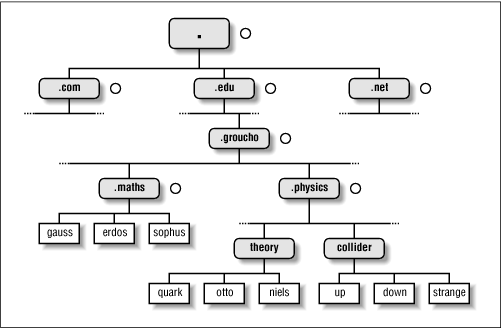Книга: Linux Network Administrator Guide, Second Edition
How DNS Works
DNS organizes hostnames in a domain hierarchy. A domain is a collection of sites that are related in some sense - because they form a proper network (e.g., all machines on a campus, or all hosts on BITNET), because they all belong to a certain organization (e.g., the U.S. government), or because they're simply geographically close. For instance, universities are commonly grouped in the edu domain, with each university or college using a separate subdomain, below which their hosts are subsumed. Groucho Marx University have the groucho.edu domain, while the LAN of the Mathematics department is assigned maths.groucho.edu. Hosts on the departmental network would have this domain name tacked onto their hostname, so erdos would be known as erdos.maths.groucho.edu. This is called the fully qualified domain name (FQDN), which uniquely identifies this host worldwide.
Figure 6.1 shows a section of the namespace. The entry at the root of this tree, which is denoted by a single dot, is quite appropriately called the root domain and encompasses all other domains. To indicate that a hostname is a fully qualified domain name, rather than a name relative to some (implicit) local domain, it is sometimes written with a trailing dot. This dot signifies that the name's last component is the root domain.
Figure 6.1: A part of the domain namespace

Depending on its location in the name hierarchy, a domain may be called top-level, second-level, or third-level. More levels of subdivision occur, but they are rare. This list details several top-level domains you may see frequently:
| Domain | Description |
|---|---|
| edu | (Mostly U.S.) educational institutions like universities. |
| com | Commercial organizations and companies. |
| org | Non-commercial organizations. Private UUCP networks are often in this domain. |
| net | Gateways and other administrative hosts on a network. |
| mil | U.S. military institutions. |
| gov | U.S. government institutions. |
| uucp | Officially, all site names formerly used as UUCP names without domains have been moved to this domain. |
Historically, the first four of these were assigned to the U.S., but recent changes in policy have meant that these domains, named global Top Level Domains (gTLD), are now considered global in nature. Negotiations are currently underway to broaden the range of gTLDs, which may result in increased choice in the future.
Outside the U.S., each country generally uses a top-level domain of its own named after the two-letter country code defined in ISO-3166. Finland, for instance, uses the fi domain; fr is used by France, de by Germany, and au by Australia. Below this top-level domain, each country's NIC is free to organize hostnames in whatever way they want. Australia has second-level domains similar to the international top-level domains, named com.au and edu.au. Other countries, like Germany, don't use this extra level, but have slightly long names that refer directly to the organizations running a particular domain. It's not uncommon to see hostnames like ftp.informatik.uni-erlangen.de. Chalk that up to German efficiency.
Of course, these national domains do not imply that a host below that domain is actually located in that country; it means only that the host has been registered with that country's NIC. A Swedish manufacturer might have a branch in Australia and still have all its hosts registered with the se top-level domain.
Organizing the namespace in a hierarchy of domain names nicely solves the problem of name uniqueness; with DNS, a hostname has to be unique only within its domain to give it a name different from all other hosts worldwide. Furthermore, fully qualified names are easy to remember. Taken by themselves, these are already very good reasons to split up a large domain into several subdomains.
DNS does even more for you than this. It also allows you to delegate authority over a subdomain to its administrators. For example, the maintainers at the Groucho Computing Center might create a subdomain for each department; we already encountered the math and physics subdomains above. When they find the network at the Physics department too large and chaotic to manage from outside (after all, physicists are known to be an unruly bunch of people), they may simply pass control of the physics.groucho.edu domain to the administrators of this network. These administrators are free to use whatever hostnames they like and assign them IP addresses from their network in whatever fashion they desire, without outside interference.
To this end, the namespace is split up into zones, each rooted at a domain. Note the subtle difference between a zone and a domain: the domain groucho.edu encompasses all hosts at Groucho Marx University, while the zone groucho.edu includes only the hosts that are managed by the Computing Center directly; those at the Mathematics department, for example. The hosts at the Physics department belong to a different zone, namely physics.groucho.edu. In Figure 6.1, the start of a zone is marked by a small circle to the right of the domain name.
- How to read
- Chapter 9. How a rule is built
- How it was written
- How to plan an IP filter
- chown
- How to place proxies
- 7. AGGREGATION WITH INDEPENDENT WORKS
- How to use this License for your documents
- 2. How to Apply These Terms to Your New Programs
- Глава 3 Виртуальные машины VMware Workstation
- Глава 4 Виртуальные машины Parallels Workstation
- Глава 11 DNS-сервер




